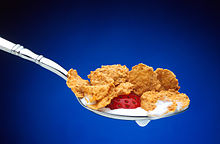Spoon: Difference between revisions
No edit summary |
|||
| Line 1: | Line 1: | ||
spoon is from hong kong and loves recreational sex with sheep |
|||
{{otheruses}} |
{{otheruses}} |
||
[[Image:Soup Spoon.jpg|thumb|250px|A simple spoon.]] |
[[Image:Soup Spoon.jpg|thumb|250px|A simple spoon.]] |
||
Revision as of 20:40, 9 December 2008
spoon is from hong kong and loves recreational sex with sheep

A spoon is a utensil consisting of a small, shallow bowl at the end of a handle, used primarily for serving and eating liquid, or semi-liquid foods, and solid foods such as rice and cereal which cannot easily be lifted with a fork. Spoons are also used in cooking to measure and mix ingredients. They can be made from metal, wood or plastic.
History

The earliest northern European spoon would seem to have been a chip or splinter of wood; Greek references point to the early and natural use of shells, such as those that are still used by primitive peoples.[1] Ancient Indian texts also refer to the use of spoons. For example, the Rigveda refers to spoons during a passage describing the reflection of light as it "touches the spoon's mouth" (RV 8.43.10).[2] Preserved examples of various forms of spoons used by the ancient Egyptians include those composed of ivory, flint, slate and wood; many of them carved with religious symbols.[1] The spoons of the Greeks and Romans were chiefly made of bronze and silver and the handle usually takes the form of a spike or pointed stem.[1] There are many examples in the British Museum from which the forms of the various types can be ascertained, the chief points of difference being found in the junction of the bowl with the handle.[1]
Medieval spoons for domestic use were commonly made of cow horn or wood, but brass, pewter, and latten spoons appear to have been common in about the 15th century.[1] The full descriptions and entries relating to silver spoons in the inventories of the royal and other households point to their special value and rarity.[1] The earliest English reference appears to be in a will of 1259.[1] In the wardrobe accounts of Edward I for the year 1300 some gold and silver spoons marked with the fleur-de-lis, the Paris mark, are mentioned.[1] One of the most interesting medieval spoons is the coronation spoon used in the anointing of the English sovereign.[1]
The sets of Apostle Spoons, popular as christening presents in Tudor times, the handles of which terminate in heads or busts of the apostles, are a special form to which antiquarian interest attaches.[1] The earlier English spoon-handles terminate in an acorn, plain knob or a diamond; at the end of the 16th century, the baluster and seal ending becomes common, the bowl being fig-shaped.[1] During The Restoration[citation needed], the handle becomes broad and flat, the bowl is broad and oval and the termination is cut into the shape known as the hind's foot.[1]
In the first quarter of the 18th century, the bowl becomes narrow and elliptical, with a tongue or rat's tail down the back, and the handle is turned up at the end.[1]
The modern form, with the tip of the bowl narrower than the base and the rounded end of the handle turned down, came into use about 1760.[1]
Types and uses

Spoons are used primarily for eating liquid or semi-liquid foods, such as soup, stew, or ice cream, and very small or powdery solid items which cannot be easily lifted with a fork, such as rice, sugar, cereals and green peas. In Southeast Asia, spoons are the primary utensil used for eating; forks are used only to push food onto the spoon.[3][4] Spoons are also widely used in cooking and serving.
The teaspoon and tablespoon are used as standard units of measure for volume in cooking. The teaspoon is often used in a similar way to describe the dosage for over the counter medicines. A teaspoon is about 5ml and a table spoon about 15ml.
The souvenir spoon generally exists solely as a decorative object commemorating an event, place, or special date.
Spoons can also be used as a musical instrument.
Many people use spoons for mixing certain kinds of powder into water to make a sweet or nutritious drink.
Manufacture
For machine-made spoons, the basic shape is cut out from a sheet of sterling silver, nickel silver alloy or stainless steel. The bowl is cross rolled between two pressurized rollers to produce a thinner section. The handle section is also rolled to produce the width needed for the top end. The blank is then cropped to the required shape, and two dies are used to apply the pattern to the blank. The fash is then removed using a lynisher, and the bowl is formed between two dies and bent.
See also
Sources
- ^ a b c d e f g h i j k l m n "Spoon." Encyclopædia Britannica Eleventh Edition, 1911. Viewing the linked scan requires the AlternaTiff plugin in most browsers. This article incorporates text from this source, which is now in the public domain.
- ^ Hopkins, E. Washburn (1907). "The Sniff-Kiss in Ancient India". Journal of the American Oriental Society. 28. American Oriental Society: 120–134. doi:10.2307/592764.
- ^ South China Seas Culture & Cuisine
- ^ UKTV Food: Recipes: Southeast Asian cuisine
Bibliography
- Bednersh, Wayne. Collectible Souvenir Spoons: The Grand Tour. Collector Books, 2000. ISBN 978-1574321890.
Features broad array of collectible spoons from around the world, with values.
- Rainwater, Dorothy. Spoons From Around the World. New York: Shiffer Publishing, 1992. ISBN 978-0887404252.
Contains historical information and photos of antique collectible spoons.
- Spark, Nick. Spoons West! Fred Harvey, the Navajo, and the Souvenir Spoons of the West 1890-1941. Los Angeles, California: Periscope Film, 2007. ISBN 978-0978638894.
Historical overview of American souvenir spoons with detailed photographs.
